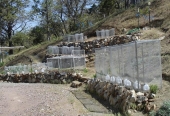
 2
2




Liz
 5
5




Idle dreamer
The Ready for Wildfire page is now at: https://readyforwildfire.org/prepare-for-wildfire/fire-smart-landscaping/
 2
2








Liz
 2
2




The holy trinity of wholesomeness: Fred Rogers - be kind to others; Steve Irwin - be kind to animals; Bob Ross - be kind to yourself

 4
4




 2
2





 4
4




List of Bryant RedHawk's Epic Soil Series Threads We love visitors, that's why we live in a secluded cabin deep in the woods. "Buzzard's Roost (Asnikiye Heca) Farm." Promoting permaculture to save our planet.
 5
5





 5
5




![Filename: Burned-yuccas.jpg
Description: Burned yucca [Thumbnail for Burned-yuccas.jpg]](/t/91448/a/64212/Burned-yuccas.jpg)
![Filename: Burned-three-acres-of-this.jpg
Description: Wildfire [Thumbnail for Burned-three-acres-of-this.jpg]](/t/91448/a/64213/Burned-three-acres-of-this.jpg)
![Filename: Trenching.jpg
Description: A month after the fire [Thumbnail for Trenching.jpg]](/t/91448/a/64214/Trenching.jpg)
 3
3




With appropriate microbes, minerals and organic matter, there is no need for pesticides or herbicides.
 4
4




Visit Redhawk's soil series: https://permies.com/wiki/redhawk-soil
How permies.com works: https://permies.com/wiki/34193/permies-works-links-threads
 5
5




This is all just my opinion based on a flawed memory

 3
3




Permies is awesome!!!

 2
2




Faye Corbett wrote:I made it through with wet hankerchiefs tied over my face and staying indoors as much as possible, with the air filters running, but it was an anxious time. My goats/cow were outside in it and nothing I could do for them.
 5
5




Living a life that requires no vacation.

 5
5




 6
6




John Daley Bendigo, Australia The Enemy of progress is the hope of a perfect plan
Benefits of rainfall collection https://permies.com/t/88043/benefits-rainfall-collection
GOOD DEBT/ BAD DEBT https://permies.com/t/179218/mortgages-good-debt-bad-debt
 2
2




Idle dreamer

 4
4




Tyler Ludens wrote:Careful plant selection and maintenance can decrease fire danger: http://www.readyforwildfire.org/Fire-Safe-Landscaping/
https://extension.wsu.edu/chelan-douglas/gardening/mg/firewise-landscapes/
Tradition is not the worship of ashes, but the preservation of fire.
 4
4




Extending 30 feet from a house, the garden zone is capable of withstanding flying embers and intense heat. Plants selected in this zone have fleshy, moist and broad leaves. Trees are preferably deciduous. This is the only zone that plants can be water, nutrient and labor dependent.
 5
5





|
Take me to the scene of the crime. And bring that tiny ad:
Rocket Mass Heater Resources Wiki
https://permies.com/w/rmh-resources
|






